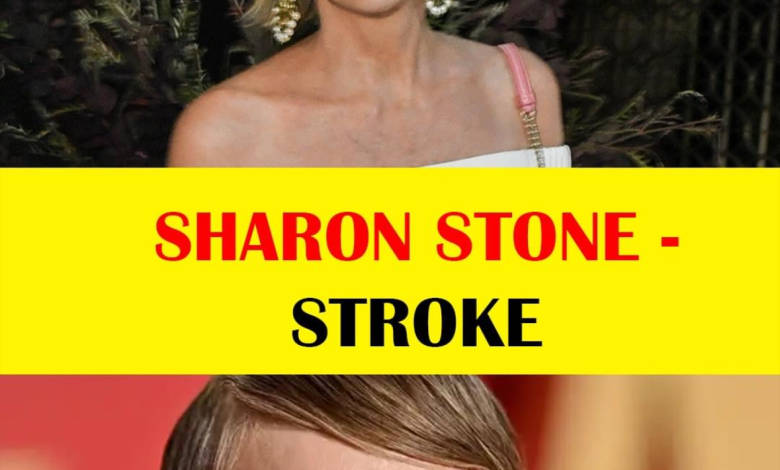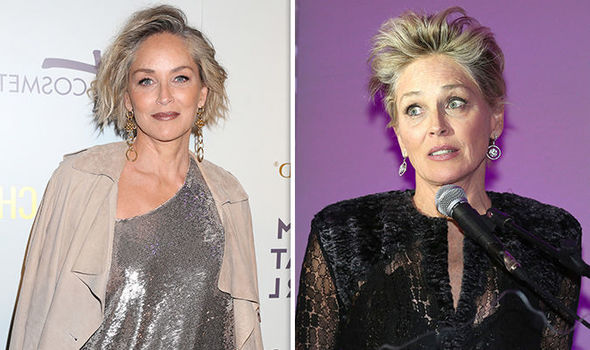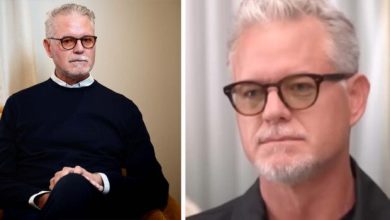
Sharon Stone says people ‘took advantage’ of her after stroke and lost millions in savings
The Basic Instinct star suffered a stroke in 2001 that led to a nine-day brain bleed, which forced her to step away from Hollywood for seven years while she recovered.
Sharon Stone has described how people “took advantage” of her financially while she was recovering from a near-fatal stroke.
The Basic Instinct star suffered a stroke in 2001 that led to a nine-day brain bleed, which forced her to step away from Hollywood for seven years while she recovered.

“People took advantage of me over that time,” the US actress told The Hollywood Reporter.
“I had $18m (£14m) saved because of all my success, but when I got back into my bank account, it was all gone.
“My refrigerator, my phone – everything was in other people’s names.
“I had zero money.”
The 66-year-old actress said instead of feeling bitter about her experience, she chooses to focus on the positive.
“I decided to stay present and let go. I decided not to hang on to being sick or to any bitterness or anger,” she said.
“If you bite into the seed of bitterness, it never leaves you. But if you hold faith, even if that faith is the size of a mustard seed, you will survive. So, I live for joy now. I live for purpose.”

‘A lot of people thought I was going to die’
Stone said the stroke changed the way her brain worked.
“A Buddhist monk told me that I had been reincarnated into my same body. I had a death experience and then they brought me back,” she said.
“I bled into my brain for nine days, so my brain was shoved to the front of my face. It wasn’t positioned in my head where it was before.
And while that was happening, everything changed. My sense of smell, my sight, my touch. I couldn’t read for a couple of years. Things were stretched and I was seeing colour patterns.
“A lot of people thought I was going to die.”

Doctors ‘decided I was faking it’
Stone previously said doctors thought she was “faking” what turned out to be a brain haemorrhage that resulted from a ruptured vertebral artery.
She told Vogue last year: “They missed it with the first angiogram and decided that I was faking it.
“My best friend talked them into giving me a second one and they discovered that I had been haemorrhaging into my brain, my whole subarachnoid pool, and that my vertebral artery was ruptured. I would have died if they had sent me home.”
The actress said she takes medication daily to address the stuttering and severe brain issues.
Stone did not share details of her brain bleed for several years after it occurred because she was worried about public reaction.
She is now a board member of the Barrow Neurological Foundation in the US, which treats “devastating brain and spine conditions”.
Sharon Stone is Back in the Spotlight After a Life-Threatening Stroke

The actress says a stroke upended her marriage, her career, her finances, and her psyche. After years of hard work, she’s healthier—and happier—than ever.
One September afternoon in 2001, actress Sharon Stone was standing behind a sofa in her San Francisco home when she experienced what she describes as a “lightning bolt” to the head so painfully shocking that it knocked her to the carpet, where she lay unconscious. After an unknown amount of time, she came to on the other side of the sofa and shakily rose to her feet. She had a throbbing headache and felt confused.

Sharon Stone says her 2001 stroke was devastating, but she’s emerged better than ever. (C) Lorenzo Agius / CPI Syndication
Stone, then 43, was at the height of her career and in robust good health—or so she thought. She’d ruled at the box office for more than a decade, shooting to superstardom with a legendary turn in 1992’s Basic Instinct. Her performance in Martin Scorsese’s Casino in 1995 landed her an Oscar nomination, sealing her status as a gutsy, brainy actress whose beauty queen looks belied a steely toughness.
A Rare Brain Bleed
That toughness would prove indispensable in the days, weeks, months, and years ahead. As she later learned, that lightning bolt was her brain hemorrhaging from a ruptured vertebral artery.
The vertebral arteries, located at the back of the neck, convey about 20 percent of the body’s blood supply to the brain, along with the internal carotid arteries—and their good functioning is critical to life.
The walls of these blood vessels are layered, like a croissant,” says Mark J. Alberts, MD, physician-in-chief at the Hartford HealthCare Ayer Neuroscience Institute in Connecticut. “A tear happens when there is damage to the wall of the vessel or an inherited weakness. After the tear, blood may enter the wall of the artery, leading to a blood clot that blocks the entire vessel. Or a piece breaks off and goes into the brain. Either way, the result can be a stroke in many cases.”
In 50 percent of cases, a preceding trauma—a car accident, a fall or blow to the head, or a neck injury—causes the tear, says Dr. Alberts. “In the other 50 percent of cases it seems to happen for no apparent reason, although there may be an underlying genetic weakness.”
Stone does not recall injuring herself in any way. Nor did she have any known risk factors for stroke. No migraines with aura. No high blood pressure or diabetes. No family history of stroke. And she didn’t smoke. But she was under mounting emotional strain due to a crumbling marriage and a looming custody battle over Roan, her newly adopted son, who was still a toddler.

Delayed Treatment
In her “discombobulated” state, Stone stumbled to her car in an attempt to seek help. She managed to get down the block, even as her leg and foot went numb. “I felt like I couldn’t drive, so I stopped and started to cry.” Some well-meaning neighbors helped her back to her house, where she was met by Roan’s nanny. “I told her I couldn’t speak, that I didn’t know what was going on. She suggested I take an aspirin.”
In her confused state, Stone did not think to call 911. She didn’t end up in the emergency department until 72 hours after the onset of her symptoms.
Diagnostic Puzzle
Once in the emergency department, the actress underwent advanced imaging tests, including a CT scan and CT angiogram. Normally an excellent tool for detecting brain hemorrhage, the scan failed to show anything in Stone’s case.
“A CT scan is almost 100 percent sensitive in detecting a subarachnoid hemorrhage if done in the first six hours,” explains Jonathan A. Edlow, MD, professor of emergency medicine at Harvard Medical School and vice chair of the department of emergency medicine at Beth Israel Deaconess Medical Center. “But as the hours pass, the scan’s sensitivity decreases. That’s because the bleeding usually stops and a flow of cerebrospinal fluid dilutes the blood, making a hemorrhage much more difficult to detect.”
When a second CT angiogram revealed the rupture, surgeons performed an interventional procedure, during which they inserted a catheter via the groin into Stone’s ruptured artery before releasing coils to induce clotting, or embolization.
The procedure, known as endovascular coiling, saved Stone’s life. But she was not at all prepared for how drastically that life was about to change.
A Struggle to Recover
“My recovery period was hell, quite frankly,” she says. “I lost 18 percent of my body mass in nine days. I came out of the hospital looking like teeth on a stick. At that time, they didn’t have stroke recovery programs. Months later, I was really, really struggling.”
Dr. Alberts isn’t at all surprised that in 2001 Stone wasn’t admitted into a rehabilitative care program after leaving the hospital, something now considered standard. “There was no mandate before 2001 for stroke patients to be seen by rehabilitative specialists and to get a professional evaluation for their ability to walk and talk and complete activities of daily living,” he says. In 2000, Dr. Alberts co-authored a paper published in the Journal of the American Medical Association that outlined recommendations for how to establish stroke centers, but they hadn’t been universally adopted by 2001.

On Her Own
Stroke is the third-leading cause of death for women, compared to the fifth-leading cause for men, a fact mainly attributed to women living longer. It’s also likely why so many women recover alone, says Sarah Song, MD, MPH, assistant professor of neurology at Rush University Medical Center in Chicago. Stone, too, faced these challenges primarily on her own. Her marriage was all but over, and she had no extended family in California.
In the months that followed her release from the hospital, Stone pursued intermittent follow-up care with her neurologist and other specialists. She experienced nagging “odd” vision and hearing problems that lasted for years, some of which she still experiences. She also battled constant fatigue and periodic seizures, as well as problems with balance, strength, and endurance. She had difficulty reading and memorizing lines, which brought her once fast-moving career to a screeching halt.
Turning a Corner
Stone’s physical and cognitive health slowly rebounded, thanks to time and a “disciplined” lifestyle far from the spotlight. She stopped drinking, changed her diet, exercised daily, and began meditating. She continued to read and practiced memorizing lines; the more she worked at it, the more progress she made.
She pushed herself to attend industry events, even if this meant painstaking preparation beforehand. She would label every outfit with directions on how and when to wear it because she says she so easily became confused. She recharged with a nap before and after every public appearance. Under her neurologist’s supervision, she gradually reduced her medications to just one small nightly dose of an anti-seizure drug. And she forged friendships with spiritual leaders, including the Dalai Lama and Desmond Tutu, among others, who helped her reject her feelings of bitterness.

She blossomed in other ways, too. “I adopted two more children [Laird and Quinn, now 13 and 11], and continued to figure out ways to parent Roan from 450 miles away.”

Back in Business
After years of sporadic TV and film appearances, Stone, who turned 60 in March, says she’s finally feeling fabulous again. And she’s reemerged as a next-level version of her former self. She’s starring in Steven Soderbergh’s HBO miniseries Mosaic, as well as an upcoming, still-untitled Martin Scorsese project. Best of all, Roan, now 17, regularly spends time with his mother and siblings and even attended this year’s Golden Globe Awards as Stone’s dapper, tuxedoed date.
“It took me a very, very long time to get here,” she says of her hard-won equilibrium. “I’ve met so many people in situations worse than my own, and I’ve learned a lot. This experience has developed my character.”

In this spirit of renewal, Stone chaired a panel for the Women’s Brain Health Initiative in Beverly Hills, CA, last October, where she shared her struggles in hopes of connecting with other women who’ve experienced similar setbacks. She also issued a call to action to focus more on women’s specific health needs and how they can differ from men’s.
“I’ve been so blessed,” she says. “It’s been a long time, a lot of determination. It finally feels like everything is coming together.”
Stroke Sense
When actress Sharon Stone experienced a brain hemorrhage in 2001, she had to forge her own path to recovery. In the intervening 17 years, a lot more is known about how to support stroke survivors and help them overcome common obstacles—such as depression and aphasia—to a full recovery.
Our stroke expert, Sarah Song, MD, MPH, assistant professor of neurology at Rush University Medical Center in Chicago, offers this valuable advice.
Being able to recognize the signs of stroke will help you respond faster and get help sooner and may result in less disability, says Dr. Song. “Remember the acronym FAST: Face, Arm, Speech, Time,” she says. “The face can droop on one side. The arm can be weak or numb. Speech can be garbled, slurred, or nonsensical. Time is of the essence.”
If you notice any of these symptoms in yourself or anyone else, call 911 and get to the hospital as quickly as possible. “Treatment for stroke is most effective for patients who arrive at the hospital within four and a half hours of the start of symptoms,” says Dr. Song.

Always call 911.
“Some people think they should drive to the emergency department,” says Dr. Song. But stroke units in hospitals across the country now work closely with first responders, she says. EMTs are trained to spot the signs of stroke and can connect patients with stroke doctors quickly to prevent long waits in waiting rooms and emergency triage. “Calling 911 is the single best way to get yourself or someone you love evaluated and treated for stroke,” she says.
Seek rehabilitative services.
Rehabilitation, with the goal of returning to independent living, is an important part of stroke recovery. In- and out-patient treatment often includes relearning self-care skills such as grooming, bathing, and dressing; mobility and communication skills; and social and vocational abilities, such as driver’s training. Programs may also include psychiatry and psychology services, audiology, and nutritional guidance.
Rehabilitative services are especially important for treating post-stroke cognitive deficits, including challenges with problem-solving, memory, and aphasia, a condition affecting the ability to either understand or process language. Speech language pathologists, neuropsychologists, and occupational therapists usually provide treatment in the home or on an outpatient basis and often employ computerized software programs to help people regain essential skills.
Persist with recovery.
Continue with therapy for as long as possible—and find a strong support network that will rally behind you for as long as it takes, says Dr. Song.
“Stroke is a sudden occurrence, something that happens in an instant—and even if the body improves, the emotional scars, fears, and anxiety can last for years to come,” she says. “It’s incredibly important to remain positive, and if you can’t do that for yourself, surround yourself with people who will push you to keep trying.”







